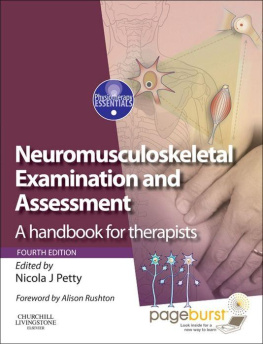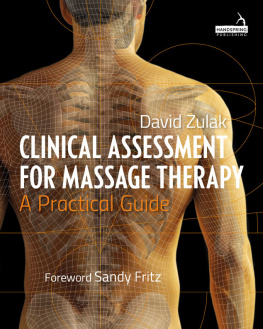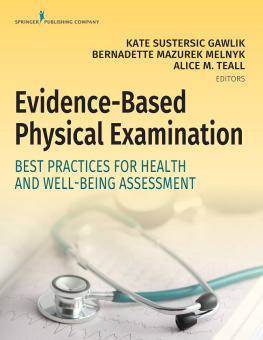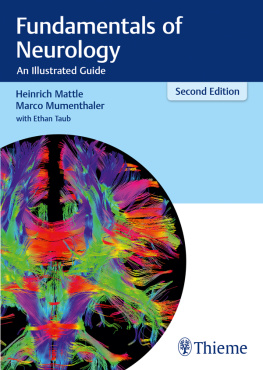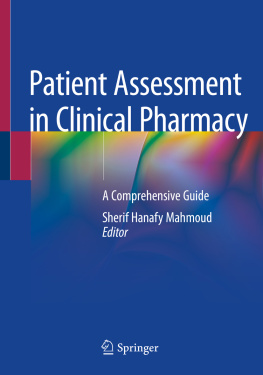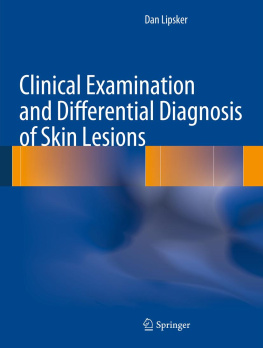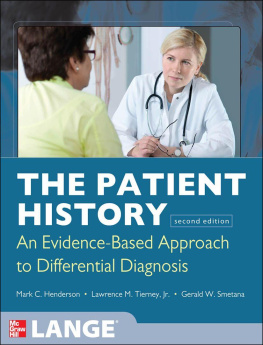Neuromusculoskeletal Examination and Assessment
A Handbook for Therapists
Fourth Edition
Nicola J. Petty, DPT MSc FMACP FHEA
Principal Lecturer, School of Health Professions, University of Brighton, UK
Churchill Livingstone
Front matter
Neuromusculoskeletal Examination and Assessment
A Handbook for Therapists
Commissioning Editor: Rita Demetriou-Swanwick
Development Editor: Nicola Lally
Project Manager: K Anand Kumar and Deepthi Unni
Designer: Kirsteen Wright
Illustration Manager: Merlyn Harvey
Illustrator: Antbits
Neuromusculoskeletal Examination and Assessment
A Handbook for therapists
FOURTH EDITION
Edited by
Nicola J Petty DPT MSc FMACP FHEA
Principal Lecturer, School of Health Professions, University of Brighton, UK
Foreword by
Dr Alison Rushton EdD MSc Grad Dip Phys Dip TP mILT FMACP

Copyright

2011 Elsevier Ltd. All rights reserved.
No part of this publication may be reproduced or transmitted in any form or by any means, electronic or mechanical, including photocopying, recording, or any information storage and retrieval system, without permission in writing from the publisher. Details on how to seek permission, further information about the Publishers permissions policies and our arrangements with organizations such as the Copyright Clearance Center and the Copyright Licensing Agency, can be found at our website: http://www.elsevier.com/permissions .
This book and the individual contributions contained in it are protected under copyright by the Publisher (other than as may be noted herein).
First edition 1997
Second edition 2001
Third edition 2006
Fourth edition 2011
ISBN 978-0-702-02990-5
British Library Cataloguing in Publication Data
A catalogue record for this book is available from the British Library
Library of Congress Cataloging in Publication Data
A catalog record for this book is available from the Library of Congress

Notices
Knowledge and best practice in this field are constantly changing. As new research and experience broaden our understanding, changes in research methods, professional practices, or medical treatment may become necessary.
Practitioners and researchers must always rely on their own experience and knowledge in evaluating and using any information, methods, compounds, or experiments described herein. In using such information or methods they should be mindful of their own safety and the safety of others, including parties for whom they have a professional responsibility.
With respect to any drug or pharmaceutical products identified, readers are advised to check the most current information provided (i) on procedures featured or (ii) by the manufacturer of each product to be administered, to verify the recommended dose or formula, the method and duration of administration, and contraindications. It is the responsibility of practitioners, relying on their own experience and knowledge of their patients, to make diagnoses, to determine dosages and the best treatment for each individual patient, and to take all appropriate safety precautions.
To the fullest extent of the law, neither the Publisher nor the authors, contributors, or editors assume any liability for any injury and/or damage to persons or property as a matter of products liability, negligence or otherwise, or from any use or operation of any methods, products, instructions, or ideas contained in the material herein.




Printed in China amend as necessary
Dedication
In memory of Geoff Maitland, visionary pioneer of musculoskeletal physiotherapy
List of contributors
Kieran Barnard, MSc BSc(Hons) MCSP MMACP, Extended Scope Physiotherapist, West Sussex Primary Care Trust, Horsham, UK
Linda Exelby, BSc(Physio) GradDipManTher FMACP, Senior Lecturer, School of Health and Emergency Professions, University of Hertfordshire and Clinical Specialist, Pinehill Hospital, UK
Laura Finucane, MSc BSc(Hons) MCSP MMACP HPC Reg, Consultant Musculoskeletal Physiotherapist, Physiotherapy Department, East Surrey Hospital, Redhill, UK
Roger Kerry, MSc FMACP, Associate Professor, Division of Physiotherapy Education, University of Nottingham, UK
Chris Mercer, MSc MCSP MMACP PGCert(Clin Ed), Consultant Physiotherapist, Western Sussex Hospitals NHS Trust, West Sussex, UK
Chris Murphy, MSc MCSP MMACP PGCert, PhysioUK, Epsom, Surrey, UK
Nicola J. Petty, DPT MSc FMACP FHEA, Principal Lecturer, School of Health Professions, University of Brighton, Eastbourne, UK
Colette Ridehalgh, MSc BSc(Hons) MMACP, Senior Lecturer, School of Health Professions, University of Brighton, Eastbourne, UK
Dionne Ryder, MSc MMACP FHEA, Senior Lecturer, School of Health and Emergency Professions, University of Hertfordshire, UK
Foreword from the first edition
The authors are to be congratulated on being able to put together the work of a number of clinical manipulative therapists, some of whom have dealt with manual therapy as a whole while others have concentrated on specific aspects of manipulative physiotherapy.
The standard of the whole field has grown almost out of recognition over the last 50 years. Latterly this coming together has been largely due to Gwen Julls prove it or lose it approach. Another significant factor has been the improved communication of a shrinking world; this has brought together the different approaches to the basis, teaching and performance of manipulative physiotherapy.
In our profession knowledge, skills and opportunities have increased substantially. It is wonderful to see these two authors, Nikki Petty and Ann Moore, making such an excellent job of putting together the contributions of all the familiar names into one volume. The coming generation needs to continue this trend; it wont all happen quickly but this start is excellent. The text is appropriate for the undergraduate, postgraduate and the practising therapist who is not fully aware of the diversity of concepts within manipulative physiotherapy.
G.D. Maitland
Foreword from the third edition
Do we need textbooks with lengthy, detailed and precise descriptions of clinical examination and assessment? Is it worthwhile for a clinician/academic to spend countless hours putting together a text that will, in part, contain information that will no longer be the latest information available by the time it goes to press? Perhaps you think that I should not be posing these questions in the foreword of a textbook, and that this is the time for praise of the author? Let me assure you that this will come later, now let me deal with the questions.
Next page
